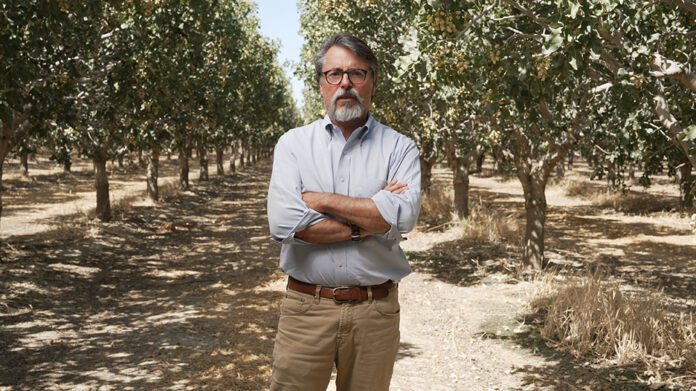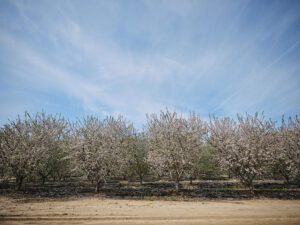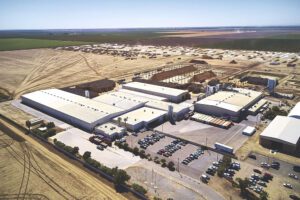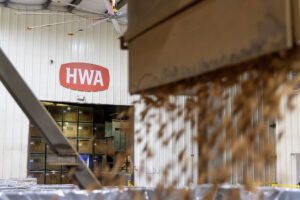
When Stuart Woolf was a young man, he shrank from public speaking. Hated it, in fact.
“I would freeze up and have an anxiety attack,” he remembered.
But those days are just a memory now. Thanks to a Dale Carnegie course, Woolf not only found the confidence to stand before an audience but put his voice to work for California agriculture.
Woolf’s ability to deal with speaking obligations and other challenges has grown through his 30 years as president and CEO of Woolf Farming and Processing. The company owns most of the 30,000 acres it manages across California’s Central Valley. Based in Fresno, the Woolf operation primarily grows almonds, pistachios and processing tomatoes. It also does some of its own processing and marketing.
But Woolf’s roles have expanded beyond the family business. He’s served on the boards of the Almond Board of California, the California League of Food Processors, the UC President’s Commission of Agriculture and Natural Resources, and the California Chamber of Commerce.
Last November, Woolf became chairman of the board of Western Growers Association. The 2,300-member organization represents growers of fresh produce in California, Arizona, Colorado and New Mexico. Western Growers’ members and their workers provide over half the nation’s fresh fruits, vegetables and tree nuts.
In June, Woolf spoke with West Coast Nut about the challenges his family company faces, his outlook for California’s almond and pistachio sectors, and his views on farming with limited water in the years ahead.

Q. California is about to harvest another big almond crop. What’s your forecast?
It’s changing rapidly based on some of the latest shipping reports. I always look at the industry’s ending inventories. If they’re growing, typically we end up with lower pricing. It wasn’t that long ago we had inventory levels at record highs. Given the shipments being reported, we’re driving industry inventory numbers down to levels where we typically have better pricing. I think the almond market remains undervalued. So, even with the likelihood of a big crop, if you consider the fundamentals, I’m optimistic.
I feel great about industry shipment levels, which continue to grow. Another thing I look at is the number of non-bearing acres in the state. That has really dropped. During these tough years, growers have planted fewer new acres. They’ve pulled out a lot of older trees. So, I think the industry is poised for a pretty good recovery.
Q. Has Woolf Farming pulled out trees or slowed down your new plantings?
We have reduced our plantings in the Westlands Water District, but over the last decade we increased them in areas with more secure water. We’re now managing properties near Orland in the north and all along the eastern slope to Arvin in the south. This was before SGMA [Sustainable Groundwater Management Act]. We replaced some of our almond acreage on the Westside with pistachios, which require less water and are more tolerant of well water. We still have a lot of almonds. But we have, during these years of low market prices, been pulling out some of our older orchards. We’re waiting for the turnaround.
Q. What’s your outlook for pistachios?
Last year, when the industry had a large carry-in and a huge crop, there was a lot of concern. But the industry has demonstrated the ability to ship its supply. This year’s crop is going to be a little smaller. Some of my friends who are large pistachio players have told me we need a crop of over 1 billion pounds to meet demand. Longer term, pistachios are poised to have a lot more volume given all the non-bearing acres.
Another consideration is pistachios have benefited from having a true market leader in the Resnicks and The Wonderful Company. They have done a terrific job helping grow that market. By comparison, the almond sector is highly fragmented with lots of sellers. It’s more of a commodity market. So, a question is, “What happens to California’s pistachio industry longer term when you have a lot more acres coming into production and there’s uncertainty about life after the Resnicks?” I don’t think they’re going away anytime soon. I hope not. But Stewart [Resnick], just like the rest of us, isn’t getting any younger. We’ve benefited greatly from his leadership. Let’s hope some form of it continues into the future.
Almonds have successfully developed a broad ingredient market. You don’t have that to the same extent with pistachios. Pistachios are more of a favored snack item, but how big can that market be? We’re really going to have to push the limits to find out.

Q. What do you see as the biggest challenges for California’s tree nut industry? What’s needed to fix them?
I’m more farmer than anything, and coming from the Westlands Water District, I would say water is the biggest challenge. Water is our limiting factor. With SGMA, the water supply is only going to get tighter. That’s going to limit our acreage. Something like 80% or 85% of the state’s almond trees are south of the Delta. Long term, it would be hard to believe we won’t see tree-nut acreage shrink.
To address the lack of water, California needs a statewide plan so that, when we do get major rainfalls, we can optimize recharging throughout the valley. If we can’t improve our overall long-term water outlook and enhance groundwater banking, we will have limited our ability to grow. Simply put, I don’t think we can regulate, restrict or reduce our way into prosperity. We must create alternative plans, something the state does not do well. We have to.

Q. At Woolf Farming, what are you paying most attention to in 2024?
I’m focused on the 30% to 40% of the lands we’ll likely fallow long-term when SGMA is fully implemented and how to optimize and preserve my family’s legacy of land.
For example, I’ve been focused on policies regarding solar installations on farmland. Specifically, will growers be able to keep their surface and groundwater rights if they install solar on their own land? We have a number of acres under long-term leases with large solar developers. We look at it almost like it’s just another crop. Whether we plant almonds for 25 years or it’s a solar project, it’s still an income stream and part of our farm rotation.
We’ve also established a number of recharge basins. And we’re looking into alternative crops. I’m planting agave, which is a drought-tolerant, climate-resilient crop. I will likely vertically integrate and build a distillery. I’m just trying to figure out what to do with this land and how to generate income using less water.
Sacramento is full of good intentions but short on good outcomes. I’ve heard others say opportunities come from challenges. If that’s the case, we have plenty of opportunities.















